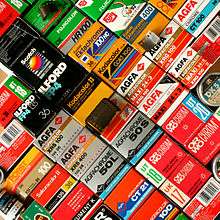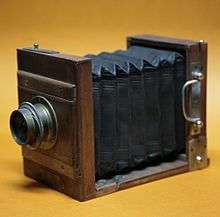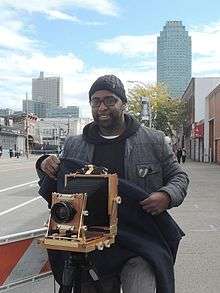Analog photography



Analog photography is photography that uses a progressively changing recording medium, which may be either chemical process based (e.g., photographic film or plate) or electronic (e.g., vidicon or CCD sensor). For more than a hundred years, this was the only kind. Analog photography has come to mean anything that is "not digital" despite some of controversy over the question of whether the use of film is a true analog process.
In a film camera that uses the gelatin-silver process, light falling upon photographic emulsions containing silver halides is recorded as a latent image. The latent image is subjected to photographic processing, which makes it visible and insensitive to light.
In a video camera or digital still camera, the signal is captured with a video camera tube or charge coupled device sensor, an analog device which sends the picture to be digitized and otherwise processed by the camera's electronics. The signal can be transmitted or recorded on a storage device for later playback.
Popularity
Analog photography is frequently used as a title for those who are keen to work with, or do work with more traditional types of photography; dedicated online communities have been established in which like-minded individuals together share and explore historic photographic practices.[1] Analog photography has become much more popular with younger generations who have become increasingly interested in the traditional photographic practice; sales in film-based cameras began to soar, and youth were seen to embrace some 19th-century technology [2] Urban Outfitters, a clothing retail chain, has joined the trend and offers more than 60 product combinations relating to cameras, most of which are film-based.
Polaroid was once a power in analog instant photography. Facing the digital revolution, Polaroid stopped production of analog instant film in 2008. A company called Impossible Project acquired Polaroid's production machines in order to produce new instant films for vintage Polaroid cameras and to revive the analog Polaroid photography technique.
Films in black and white still produced as of 2013 include:
- Adox CHS 100
- Adox CHS 25
- Adox CMS 100
- Adox Silvermax
- Film Washi "W" 25
- FOMA FOMAPAN 100 Classic[3]
- FOMA FOMAPAN 200 Creative
- FOMA FOMAPAN 400 Action
- FOMA FOMAPAN R 100
- FOMA RETROPAN 320 soft
- FujiFilm Neopan Acros 100
- Ilford Pan F Plus 50
- Ilford HP5 Plus 400
- Ilford FP4 Plus 125
- Ilford Delta 100
- Ilford Delta 400
- Ilford Delta 3200
- Ilford XP2 Super
- Ilford SFX 200
- Kentmere 400
- Kodak TMX 100
- Kodak TMY-2 400
- Kodak TRX 400
- ORWO UN 54[4]
- ORWO N 74 plus
Rollei also markets a line of black and white films.
German photographic supply house Fotoimpex produces Adox films and fiber-based photographic papers. The company is also running a commitment-to-buy campaign to determine if there is sufficient interest to attempt to re-issue Polytonwarm - a highly specialized fiber-based paper originally produced by now defunct Hungarian manufacturer FORTE.
See also
- Analog signal
- Digitizing
- Digital photography
- Digital versus film photography
- List of photographic processes
References
| Wikivoyage has travel information for Travel photography using film. |
- Glenn D. Considine, Van Nostrand's Scientific Encyclopedia, Two-Volume Set, 9th Edition (Hoboken, NJ: Wiley, 2002)
- Peter M.B. Walker, Chambers Technical Dictionary (Edinburgh: Chambers 1999)
- William J. Mitchell, The reconfigured eye: visual truth in the post-photographic era (MIT Press, 1994)
- ↑ "Archived copy". Archived from the original on 2006-10-02. Retrieved 2006-11-04.
- ↑ http://news.cnet.com/8301-1023_3-20062810-93.html
- ↑ "FOMA - Films". FOMA. Retrieved 2016-10-30.
- ↑ "ORWO FilmoTec - Camera Films". ORWO FilmoTec GmbH. Retrieved 2016-10-30.